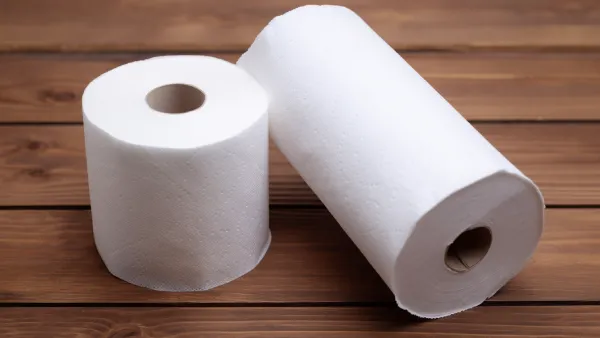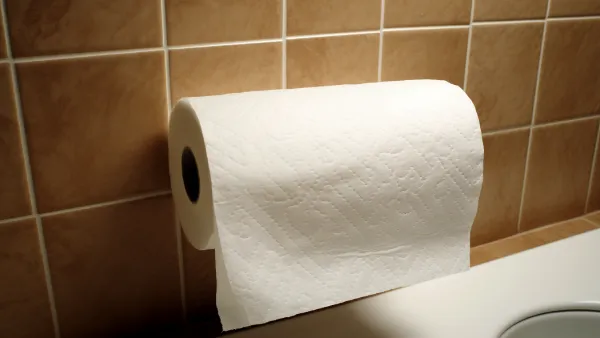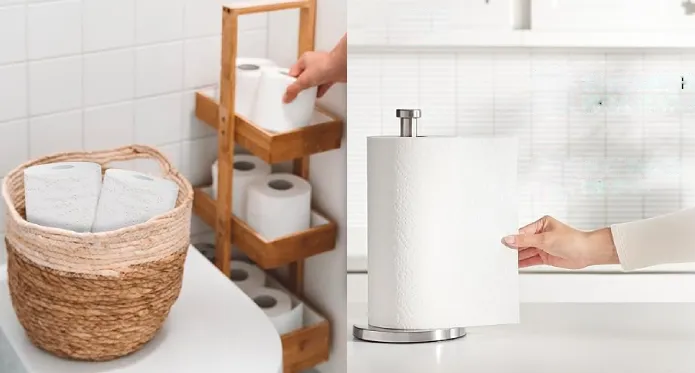Last Updated on October 18, 2023
Toilets require two essential products: toilet paper and paper towels. While they may both seem like sheets of paper on a roll at first glance, a closer look reveals distinctive characteristics that set them apart.
One key difference lies in their fiber composition. Toilet paper primarily consists of short fibers derived from mechanical pulping, hardwoods, or recycled fiber, making it soft and suitable for personal hygiene during toileting.
Conversely, paper towels contain a higher percentage of longer softwood fibers and chemical pulps, so they’re stronger and better at cleaning and absorbing spills.
Another noticeable contrast is in their texture. Toilet paper is designed to be soft and gentle, conforming to skin curves comfortably, whereas paper towels boast a rougher texture.
Here, we’ll explain all the key differences between toilet paper and paper towels so you’ll know when to use each.
7 Differences Between Toilet Paper & Paper Towel

The difference between toilet paper and paper towels can be found in many categories. The following are among them:
- Fiber composition
- Texture
- Strength and thickness
- Usage
- Packaging
- Water dissolvability
- Septic tank compatibility
Now, we will discuss the distinctions between paper towels and toilet paper within these categories.
Fiber Composition
There are some clear differences regarding the fiber composition of toilet paper and paper towels.
Toilet paper is typically made from short fibers derived from mechanical pulping, hardwoods, and recycled materials. As opposed, paper towels contain a higher proportion of chemical pulp and longer softwood fibers.
Texture
Toilet paper and paper towels also have distinct textures. The toilet paper is made to be soft, gentle, and comfortably conform to your skin’s curves.
On the other hand, paper towels have a rougher texture designed for cleaning, making them unsuitable for use in sensitive areas.
Strength and Thickness
Paper towels are generally more substantial and stronger than toilet paper. They can hold up to the toughest cleaning tasks and quickly absorb a considerable volume of liquid.
The thickness of paper towels also ensures that they do not disintegrate or tear when used to clean up spills and messes.
Comparatively, toilet paper may not have the same durability as it is designed to break down quickly after use.
Usage
The purpose of toilet paper and paper towels is different. Toilet paper is exclusively designed for personal hygiene during toileting.
In contrast, paper towels serve a broader range of uses, such as cleaning surfaces and spills in your toilet. The paper towels are great for drying your hands or wiping your face when cleaning up a mess quickly.
Packaging
The packaging of these two paper products differs significantly. Toilet paper usually comes in rolls equipped with a central cardboard tube.
In contrast, paper towels are available in both rolls with perforated sheets and folds in a box. The packaging design has some impact on the functionality and utility of each.
Toilet paper rolls are easy to store, take less space, and are convenient to carry while traveling. Contrary to this, paper towels in a box or on a roll are easy to pull out to use and provide quick access to cleaning supplies.
Water Dissolvability
Toilet paper and paper towels bear different water dissolvability properties. When wet, toilet paper breaks up easily because it is engineered to disintegrate upon contact with moisture. Its shorter, less tightly woven fibers allow for quick breakdown.
In contrast, paper towels are designed for durability, even when wet. They are made from longer and stronger fibers, which make them more resistant to tearing or dissolving in water.
Septic Tank Compatibility
The compatibility of toilet paper and paper towels with septic tanks varies significantly.
Toilet paper can be flushed because it is septic tank-friendly and engineered to break down quickly in septic systems. But paper towels are not septic-tank-friendly, so they cannot be flushed down the toilet.
What happens if you use paper towels as toilet paper?

Using paper towels instead of toilet paper is not recommended because it can lead to significant plumbing issues. As paper towels are thicker and made from cellulose fibers, they do not readily dissolve in water.
When flushed down the toilet, they can accumulate and clog the plumbing system, potentially causing blockages and the need for costly repairs.
Toilet paper, in contrast, is specifically designed to break down quickly in water, preventing such plumbing problems.
Therefore, using paper towels as a substitute for toilet paper can result in plumbing hassles and should be avoided to maintain the proper functioning of your toilet and sewage system.
How many times can disposable paper towels be used?
Disposable paper towels are designed to be used only once. Their loosely woven structure allows water to travel between the fibers, even against gravity, due to the capillary effect.
This absorbent quality makes them effective for absorbing liquids and spills in a single use. Attempting to reuse disposable paper towels may not be sanitary and can compromise their absorbency, as they are not designed for multiple uses.
It’s best to follow the intended use guidelines and dispose of them properly after a single use to maintain cleanliness and hygiene.
How should you dispose of paper towels properly?
To dispose of paper towels correctly, always throw them in the trash, never in the toilet. Flushing paper towels down the toilet can cause serious plumbing issues and result in costly repairs.
Additionally, disposing of paper towels in the trash helps prevent environmental problems, as they can clog drains and cause water pollution.
So remember, always dispose of your paper towels in the trash to keep your plumbing and the environment healthy.
What size is a toilet paper roll?
A traditional toilet paper roll generally has a width between 3.9 inches and 4.5 inches. It is noteworthy that commercial and industrial-scale toilet paper rolls may have larger diameters to keep up with the demands of extensive usage.
These metrics are fairly consistent, simplifying their placement on most toilet paper dispensers and ensuring user convenience in everyday settings, including homes, offices, and public bathrooms.
Be Consistent with the Proper Use of Toilet Paper and Paper Towels for Better Hygiene
While toilet paper and paper towels may seem interchangeable, they have distinctive characteristics that set them apart.
Understanding their differences in fiber composition, texture, strength and thickness, usage, packaging, water dissolvability, and septic tank compatibility can help you make better purchasing and usage decisions.
Remember, toilet paper is septic-tank-friendly, soft, and gentle for personal hygiene, whereas paper towels are more durable and designed to absorb spills.
Misusing paper towels as toilet paper can lead to costly plumbing repairs, so stick to their intended purpose. Always use each product as directed and dispose of them appropriately to avoid any adverse environmental impacts.

